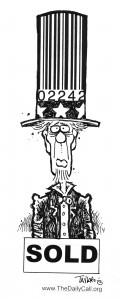When artist Theaster Gates transformed a house on Chicago’s derelict South Side into an artwork open to the community, it was just the beginning.
By Tim Adams The Guardian (5/3/15)The 2008 sub-prime mortgage crash looked a lot like the apocalyptic end of something in many American cities, but to Theaster Gates it was a new beginning. Gates, these days director of arts and public life at the University of Chicago, whom ArtReview likes to call “the poster boy for socially engaged art”, was then a somewhat overlooked potter and frustrated town planner. He used the opportunity afforded by the collapse of Fannie Mae and Freddie Mac to buy a bungalow in the derelict South Side of Chicago for $16,000, then about as much as he could afford.
Gates, 34 at the time, set about making the clapboard bungalow his new artistic medium. He gutted it, “repurposed” the scrap to make shelves for 14,000 art books plundered from a closed-down bookstore, and covered the exterior with vertical strips of weathered wood. He created a “soul food kitchen”, and a room to hold a floor-to-ceiling collection of photographic slides rescued from the skip. He called the bungalow the Archive House, and opened it to the neighbourhood.
Reimagined lost dreams
So far it sounds like any number of community projects. But Gates wasn’t finished there. He used leftover scrap wood to build shoe-shine stands – referencing a history of black poverty and labour – and sold them for thousands of dollars at an art fair in Miami. With the proceeds, Gates bought another property on Dorchester Avenue, the same street as the first. He reimagined it in the same way, bought all the records from a defunct, once famous local record store, Dr Wax, housed them there, and called it the Listening Room. By now he was on a roll.
Over the seven years since, Gates has used the same principle – buying and stripping out properties in his neighbourhood, a mile or two south of the university but a different world entirely, remaking some of the scrap as art, selling it, and buying more property to create community spaces and houses for local artists and others. In 2011 he made a series of beautiful textured canvases covered in spectrums or coils of reclaimed fire hoses, called them In the Event of a Race Riot. One set recently sold at Christie’s for £250,000. Always channelling the money back into the “Dorchester Projects”, he is inexorably remodelling his entire neighbourhood which had previously been hollowed out for two or three decades by poverty and crime. Gates now employs and houses 60 “artists and makers”, and his practice is expanding to other cities in the American rust belt – St Louis, Missouri; Akron, Ohio; Gary, Indiana. His ambition is growing too. Two years ago he saved from demolition a bank building, with classical portico and marble interior, the last civic building standing on Stony Island Avenue, the main drag two blocks from his home. The bank was flooded out and long-abandoned. Rahm Emanuel, Chicago’s mayor, and Gates’s most reliable patron, sold it to him for a dollar, on the basis that the artist would raise the money to renovate it. To this end Gates has created bonds from the marble tiles of the bank’s former urinals – readymades, indeed – inscribed, “In art we trust”. He has sold 100 of them for $5,000 each to get the renovation started. In the kind of neat reversal he lives for, he plans to sell more of his urinal bonds to collectors at the forthcoming Basel art fair. “I’m hoping Swiss bankers will bail out my flooded South Side bank in the name of art,” he says, with a broad grin.
Gates is telling me some of this in the self-renovated shell of a corner house in which he lives alone, on Dorchester Avenue, over the road from the Listening Room (the ground floor is another venue, the Black Cinema House). He is an energising presence, precise in his movements, comfortable in his skin. In conversation he slides easily between registers, from knowing bursts of street slang to situationist theory – references to “French cats like Guy Debord” – always thoughtful but never quite in earnest. His voice is rich in cadence; occasionally he will burst into song. When I ask him about The Wire at one point, he suggests he is more of a Downton Abbey obsessive. If he were a superhero, he intones in a sudden surprising tenor, he would be the Unknown Craftsman, “You know! Mask and cape, making anony-mous artistic inter-ventions, chang-ing the cit-y for-eeever.”
Gates is 41. This week he has new work – painting and pottery – filling the hangar-like White Cube gallery in Bermondsey in south London. He is planning another large-scale show at the Venice Biennale, which may include his playful Zen-gospel band, the Black Monks of Mississippi, among other things (at 13, Gates was director of his church’s gospel youth choir). Earlier this year he was awarded the prestigious Artes Mundi prize in Cardiff and shared the £40,000 with his fellow nominees.
A child of dislocation
He has not always been the “darling of the international art world”. He grew up in the tough West Side of Chicago, at a time of increasing dislocation in the city. He was the youngest of nine children and the only boy. His sisters now mostly work in public service but when younger they all dabbled, he has said, in “Black Pantherism”. His late mother was a schoolteacher and had him read widely from an early age, a habit that won him a place at a smart North Side school and the sense of “walking in two worlds since fifth grade”. His father was a roofer and Gates worked in holidays as his labourer. He always had an idea roughly where he wanted to get to – he has a degree in urban planning, and an unusual joint masters in religion, ceramics and city design – but it took him a while to get here.
“I knew immediately after graduating that the kind of tactical planning I wanted to do I wouldn’t be able to do through a traditional city department,” he says – though he was a “bow-tie wearer” in city hall for a while. “I realised it was actually developers who changed cities. It bugged me that the people with the most agency, the most entrepreneurial spirit, were also the people with the least consciousness about the needs of a place. I went after having more agency…”




